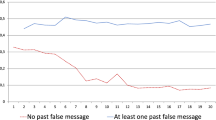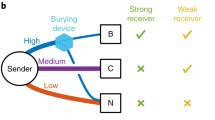Abstract
As social networking sites continue to proliferate, online deception is becoming a significant problem. Deceptive users are now not only lone wolves propagating hate messages and inappropriate content, but also are more frequently seemingly honest users choosing to deceive for selfish reasons. Their behavior negatively influences otherwise honest online community members, creating a snowball effect that damages entire online communities. In this paper, we study the phenomenon of deception and attempt to understand the dynamics of users’ deception, using a game-theoretic approach. We begin by formulating the decision process of a single user as a Markov chain with time-varying rewards. We then study the specific optimization problem a user may face in choosing to deceive when they are influenced by (1) their potential reward, (2) peer pressure and (3) their deception comfort level. We illustrate reasonable equilibria can be achieved under certain simplifying assumptions. We then investigate the inverse problem: given equilibria, we show how we can fit a model to the data and how this model exposes information about the social structure.





Similar content being viewed by others
Notes
The data does not allow us to establish whether a user is directly replying to another one within the same thread or not.
References
Gorsky P, Caspi A (2006) Online deception: Prevalence, motivation, and emotion. CyberPsychology and Behavior 9(1)
Ackerman MS, Cranor LF, Reagle J (1999) Privacy in e-commerce: examining user scenarios and privacy preferences. In: Proceedings of the 1st ACM Conference on Electronic Commerce, EC ’99. ACM, New York, pp 1–8
Agichtein E, Castillo C, Donato D, Gionis A, Mishne G (2008) Finding high-quality content in social media. In: Proceedings of the international conference on Web search and web data mining. ACM, pp 183–194
Barbier G, Liu H (2011) Information provenance in social media. In: Social Computing, Behavioral-Cultural Modeling and Prediction. Springer, New York, pp 276–283
Barnes SB (2006) A privacy paradox: social networking in the United States. First Monday 11(9):11–15
Baye M, Tian G, Zhou J (1993) Characterizations of the existence of equilibria in games with discontinuous and non-quasiconcave payoffs. Rev Econ Stud 60:935–948
Bell J, Machover M (1977) A course in mathematical logic. North-Holland, Amsterdam
Berger A, Pietra SD, Pietra VD (1996) A maximum entropy approach to natural language processing. Comput Linguist 22(1):39–71
Bonneau J, Preibusch S (2010) The privacy jungle: on the market for data protection in social networks. In: Economics of information security and privacy. Springer, pp 121–167
Castillo C, Mendoza M, Poblete B (2011) Information credibility on Twitter. In: Proceedings of the 20th international conference on World wide web. ACM, New York, pp 675–684
Chung C, Pennebaker JW (2008) Revealing dimensions of thinking in open-ended self-descriptions: an automated meaning extraction method for natural language. J Res Pers 42(1):96–132
Cranor LF, Reagle J, Ackerman MS (2000) Beyond concern: understanding net users’ attitudes about online privacy. MIT Press, Cambridge
David S, Pinch T (2006) Six degrees of reputation: the use and abuse of online review and recommendation systems. First Monday 11(3). http://journals.uic.edu/ojs/index.php/fm/article/view/1315
Donath J (2014) Signs, truth and design. Forthcoming. http://smg.media.mit.edu/people/judith/signalsTruthDesign.html
Fassim. Fassim: a forum spam prevention plugin. http://www.fassim.com/about/. Accessed Dec 2013
Giles J (2005) Internet encyclopaedias go head to head. Nature 438: 900–901
Goffman E (1959) The presentation of self in everyday life
Griffin C, Mercer D, Fan J, Squicciarini A (2012) Two species evolutionary game model of user and moderator dynamics. In Proceedings of ASE International Conference on Social Informatics, Washington, DC, USA, Dec 14–16
Griffin C, Squicciarini A (2012) Toward a game theoretic model of information release in social media with experimental results. In: Proceedings of 2nd Workshop on Semantic Computing and Security, San Francisco, CA, USA, May 28
Griffin C, Testa K, Racunas S (2011) An algorithm for searching an alternative hypothesis space. IEEE Trans Syst Man Cyber B 41(3):772–782
Griffin C, Kesidis G (2013) Good behavior in a communications system with cooperative, greedy, and vigilante players. CoRR, abs/1306.3127 (http://arxiv.org/abs/1306.3127)
Heffernan V (2006) The lonelygirl that really wasn’t. The New York Times. http://www.nytimes.com/2006/09/13/technology/13lonely.html?_r=2.
Michael D (2002) Intriligator. Mathematical Optimization and Economic Theory. SIAM Publishing
Patricia J (2012) The stranger among us: Identity deception in online communities of choice. Rutgers University
Johnson PE, Grazioli S, Jamal K, Berryman RG (2001) Detecting deception: adversarial problem solving in a low base-rate world. Cognitive Sci 25(3):355–392
Kesidis G, Tagpong A, Griffin C (2009) A sybil-proof referral system based on multiplicative reputation chains. IEEE Comm Lett 13(11):862–864
Kurve A, Kesidis G (2011) Sybil detection via distributed sparse cut monitoring. In: Proceedings of the IEEE International Conference on Communications. ICC’11, Kyoto, Japan, June
Lampe CAC, Ellison N, Steinfield C (2007) A familiar face(book): profile elements as signals in an online social network. In: Proceedings of the SIGCHI conference on Human factors in computing systems, CHI ’07. ACM, New York, pp 435–444
Manning CD, Schütze H (1999) Foundations of statistical natural language processing. MIT Press, Cambridge
Moh TS, Murmann AJ (2010) Can you judge a man by his friends?-enhancing spammer detection on the twitter microblogging platform using friends and followers. Information Systems, Technology and Management, pp 210–220
Pennebaker JW, Mehl MR, Niederhoffer KG (2003) Psychological aspects of natural language use: our words, our selves. Ann Rev Psychol 54: 547-577
Reddit. http://reddit.com
Reny PJ (1999) On the existence of pure and mixed strategy nash equilibria in discontinuous games. Econometrica 67(5):1029–1056
Santos E Jr, Johnson G Jr (2004) Toward detecting deception in intelligent systems. In: Defense and Security. International Society for Optics and Photonics, pp 130–141
Stop Forum SPam (2012) http://www.stopforumspam.com.
Squicciarini A, Griffin C (2012) An informed model of personal information release in social networking sites. In: 2012 ASE/IEEE Conference on Privacy, Security, Risk and Trust, Amsterdam, Netherlands, Sep 3–5. http://arxiv.org/abs/1206.0981
Squicciarini AC, Sundareswaran S, Griffin C (2011) A game theoretical perspective of users’ registration in online social platforms. In: Third IEEE International Conference on Privacy, Security, Risk and Trust. MIT, Cambridge, Oct 9–11
Strater K, Lipford HR (2008) Strategies and struggles with privacy in an online social networking community. In: Proceedings of the 22nd British HCI Group Annual Conference on People and Computers: Culture, Creativity, Interaction-Volume 1. British Computer Society, pp 111–119
Suler JR, Phillips WL (1998) The bad boys of cyberspace: deviant behavior in a multimedia chat community. Cyber Psychol Behav 1:275–294
Sureka A (2011) Mining user comment activity for detecting forum spammers in youtube. CoRR, abs/1103.5044
The Daily Dot (2011) Dot 10: The 10 most important people on reddit
The Register Uk (2001) Murderer confesses on anandtech forum. http://www.theregister.co.uk/2001/05/18/murderer_confesses_on_anandtech_forum/
Vartapetiance A, Gillam L (2012) I don’t know where he is not: does deception research yet offer a basis for deception detectives?. In: Proceedings of the Workshop on Computational Approaches to Deception Detection. Association for Computational Linguistics, pp 5–14
Wang AH (2010) Detecting spam bots in online social networking sites: a machine learning approach. In: Proceedings of the 24th annual IFIP WG 11.3 working conference on Data and applications security and privacy, DBSec’10. Springer-Verlag, Berlin, Heidelberg, pp 335–342
Acknowledgments
Portions of Dr. Griffin’s work were supported by the Army Research Office under Grant W911NF-11-1-0487. Portions of Dr. Griffin’s and Dr. Squicciarini’s work were supported by the Army Research Office under grant W911NF-13-1-0271.
Author information
Authors and Affiliations
Corresponding author
Additional information
This article is part of the Topical Collection on Uncovering Deception in Social Media.
Rights and permissions
About this article
Cite this article
Squicciarini, A., Griffin, C. Why and how to deceive: game results with sociological evidence. Soc. Netw. Anal. Min. 4, 161 (2014). https://doi.org/10.1007/s13278-014-0161-0
Received:
Revised:
Accepted:
Published:
DOI: https://doi.org/10.1007/s13278-014-0161-0




